In an evolving world, user demands shift as rapidly as technology, forcing businesses to adapt at an ever-increasing rate. Traditional, rigid methodologies struggle to keep pace, driving the need for more flexible approaches to project management like Agile. Reflecting this paradigm shift, it’s no surprise to see 71% of companies adopting Agile in their SDLC (Software Development Life Cycle).
Agile’s popularity stems from the benefits its flexible and iterative nature provides software development companies. According to a survey by McKinsey&Company, 93% of Agile organisations reported improved customer satisfaction and operational performance while 76% reported increased employee engagement as compared to non-Agile business units. A more recent study found increased business value as a top contributor to organisations adopting Agile, with 41% of businesses citing two primary reasons: prioritising customer value and accelerating time to market.
Whether you’re a startup founder or decision maker at a small to medium-sized business, this article will provide you with a holistic understanding of Agile software development. We’ll explore core Agile principles, where they work, and why they might fit you well. We’ll break down different Agile methodologies, and the various Agile methodology stages along with the tools and strategies you need to embrace Agile within your software development team.
With this knowledge, you’ll be well-positioned to evaluate software development partners and whether they employ healthy agile practices that lead to successful project delivery.
What is the Agile SDLC
In software development, Agile is a set of principles representing a mindset towards software development prioritising functionality, customer focus, flexibility, and responsiveness to change. Its origins can be traced back to 2001 when a group of software developers formed a more flexible approach to software development that could facilitate evolving requirements.
They drafted the Agile Manifesto, a document that outlines four key values and twelve principles that form the foundation of the Agile development life cycle. By utilising iterative and incremental development techniques, the Agile SDLC was designed to produce high-quality software quickly and efficiently by manifesting agile values and principles.
The four key Agile values
These values emphasise a people-centric approach to software development, where delivering business value is the primary objective:
- Individuals and interactions over processes and tools.
- Working software over comprehensive documentation.
- Customer collaboration over contract negotiation.
- Responding to change over following a plan.
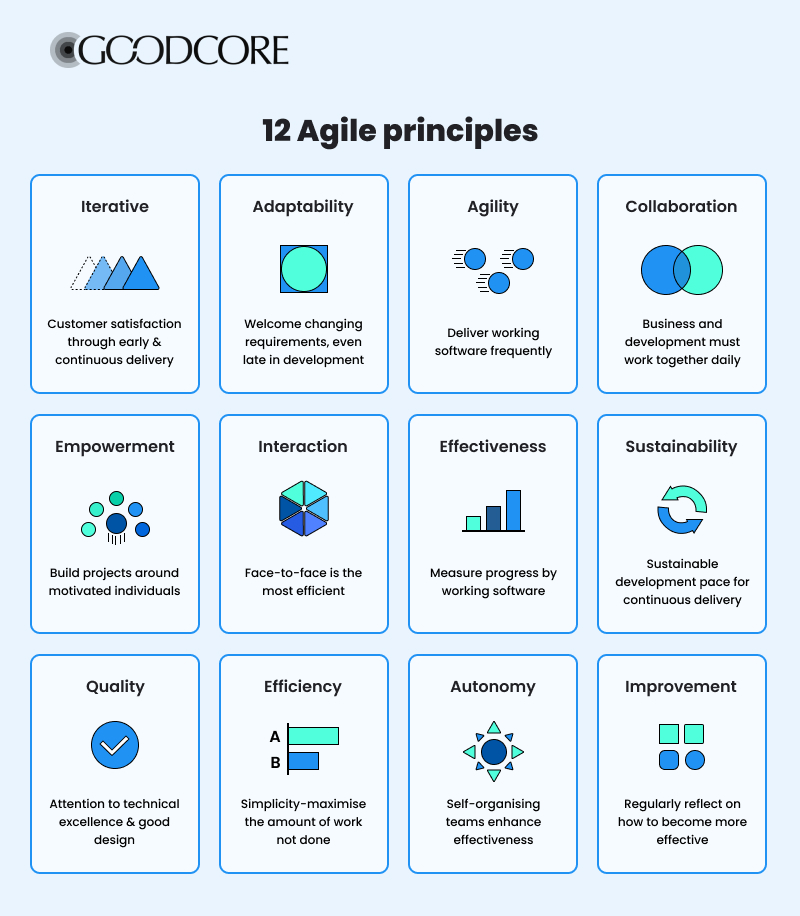
Source: 17th State of Agile Report , The Impact of Agile. Quantified
Agile SDLC vs traditional SDLCs
Traditional software development methodologies like Waterfall follow a structured, successive, and sequential approach with distinct phases like requirements analysis, design, and implementation. The whole project is passed through a linear, phase-based approach where each phase must be completed before moving on to the next. This leaves limited opportunity for adjustments, leading to situations where after devoting months of effort to a project, you discover the final product falls short of expectations or doesn’t align with intended goals.
Read Also: Top 6 SDLC Methodologies and How to Choose the Best One?
Agile vs Waterfall Software Development Life Cycle
The linear nature of the Waterfall SDLC restricts the ability to incorporate relevant insights or make adjustments, especially in the early stages of development. By the time issues become apparent, it’s often too late to make any significant changes without incurring substantial costs and delays.
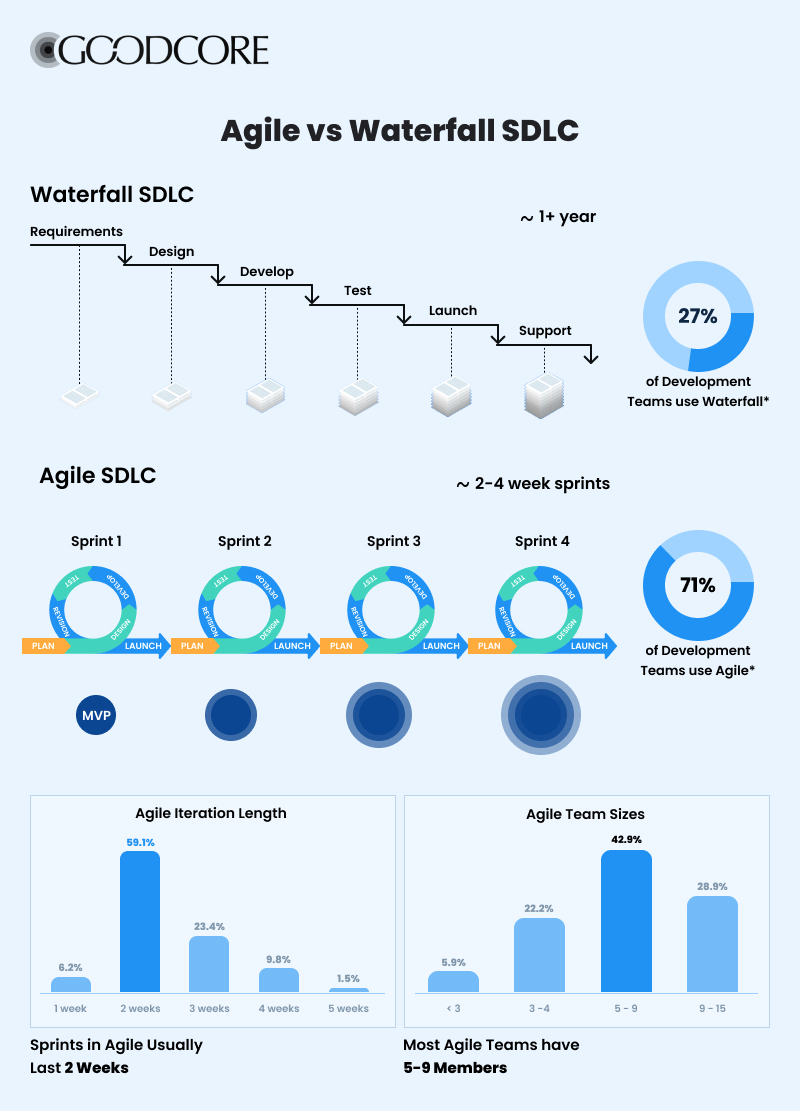
Source: 17th State of Agile Report , The Impact of Agile. Quantified
Elevate your next venture with our Agile SDLC expertise!

Yasin Altaf
Executive Director,Forbes Technology Council Member
Agile addresses the shortcomings of Waterfall by breaking development into smaller, manageable chunks that are delivered in shorter bursts of time called sprints, typically lasting 2 weeks. The focus is on delivering core functionality first, and iterative development prioritising the release of more critical features first that reflect user feedback. Iterative development paired with a constant feedback loop significantly decreases time to market, improves product market fit, and reduces development failure risk. Let’s quickly compare Agile vs Waterfall:
| Dimension | Agile SDLC | Waterfall SDLC |
| Approach | Iterative and incremental | Sequential |
| Flexibility | High | Low |
| Time to Market | Rapid | Slow |
| Delivery | Iterative, 2-4 weeks | ~1+ years |
| Customer Involvement | High, ongoing feedback | Limited, mainly initially |
| Planning | Continuous, ongoing | Upfront and detailed |
| Testing | Incremental throughout | Staged, at milestones |
| Roles and Responsibilities | Self-organising teams | Clearly defined roles |
| Documentation | Minimal, collaborative | Extensive, upfront |
Read also: Top 6 SDLC methodologies and how to choose the best one?
A case in point: How adopting Agile software development helped the FBI rescue a $600m failure
Take the FBI’s Sentinel Project as an example, where they wanted to create a Virtual Case File system. Their initial attempt using Waterfall resulted in thousands of pages of documents, seven hundred thousand lines of code and inadequate software that was deemed unusable. Their second attempt, the Sentinel Project, exhausted most of its budget while only delivering two of four phases with a product that was rejected by stakeholders. Finally, after burning through 600 million dollars and a decade, the project’s methodology was shifted to agile for the remaining phases.
Under an Agile model, the design was broken into 670 user stories, and the workforce was cut by 85% and organised into smaller, self-managed teams. Teams worked in two-week sprints, with a demo at the end of each sprint, fostering visibility and accountability. By continuously incorporating real-world feedback, they were able to create a system that was successful in replacing their existing system while significantly reducing cost.
Is Agile always the answer?
Ultimately, there is no one-size-fits-all approach, to answer which development approach is right for a project you need to understand its nature and context. A simple, straightforward project with fixed functions is likely to be more suited to Waterfall. Whereas, Agile may be more suited for projects that are more uncertain with evolving requirements. Or simply, Agile might suit a project better, but given the constraint of a team unfamiliar with Agile or lacking necessary skills, Waterfall may be less disruptive.
Sahar Kanani, a Project Management Professional asserts: “As much as I’m an advocate for agile, I also believe you couldn’t land on the moon or even build a bridge without waterfall.” There’s a chance that Agile may have fast-tracked the moon landing, leading to a more definitive space race victory. However, that may come at the cost of higher casualties or disaster events. Delicate projects like this require extensive planning before implementation.
| Project Scope | Suitable SDLC | Why? |
| Evolving Requirements | Agile | Adapts to changing needs and priorities. |
| Fixed, Straight-Forward Requirements | Waterfall | Clear roadmap for a well-defined project. |
| Need Low Time-to-Market | Agile | Iterative development delivers frequent results. |
| Highly Regulated or Safety-Critical | Waterfall | Strict planning minimises risks. |
| User Feedback is Important | Agile | Integrates feedback for continuous improvement. |
| Inexperienced Team | Waterfall | Teams can follow a prescriptive framework |
| Collaborative & Adaptable Team | Agile | Leverages team strengths in a flexible environment. |
Types of Agile methodologies
Think of Agile as an umbrella term, an overarching philosophy towards project management, particularly software development. Underneath it are various agile methodologies that serve to practically implement agile. Notably, popular agile methodologies include Scrum, Kanban, Scrumban, and Extreme Development, along with hybrid approaches that combine elements from different methodologies.
| Agile Frameworks | Salient Features |
| Scrum | Iterative and Incremental Delivery
Fixed-length sprints (~2-4 weeks) Roles: Product Owner, Scrum Master, Development Team Artefacts: Product Backlog, Sprint Backlog, Product Increment Ceremonies: Grooming, Sprint Planning, Daily Stand-up, Sprint Review |
| Kanban | Visual Workflow Management
Workflow Visualisation and Work in Progress (WIP Limiting) No time-bound iterations, continuous flow of work |
| ScrumBan | Combines Scrum and Kanban
Scrum Sprints & Ceremonies + Kanban Boards & WIP Limits |
| Lean | Focuses on eliminating waste & improving efficiency
Continuous improvement & value delivery to customer |
| Extreme Programming | Encourages rapid feedback and frequent releases
Pair Programming Test-driven development Continuous Integration |
| Hybrid | Combines Agile & Waterfall
Structured Waterfall Phases + Iterative Agile Development Agile practices with Waterfall planning and documentation |
Despite Agile encompassing a diverse range of methodologies, Scrum and Kanban stand out as the most popular. Scrum leads the charge with 87% of software development teams using it, while Kanban trails behind with 56% adoption. Surprisingly, in third place, we find ScrumBan at 27%, a hybrid approach that combines the visual management and continuous flow of Kanban with the sprints, roles, and ceremonies of Scrum.
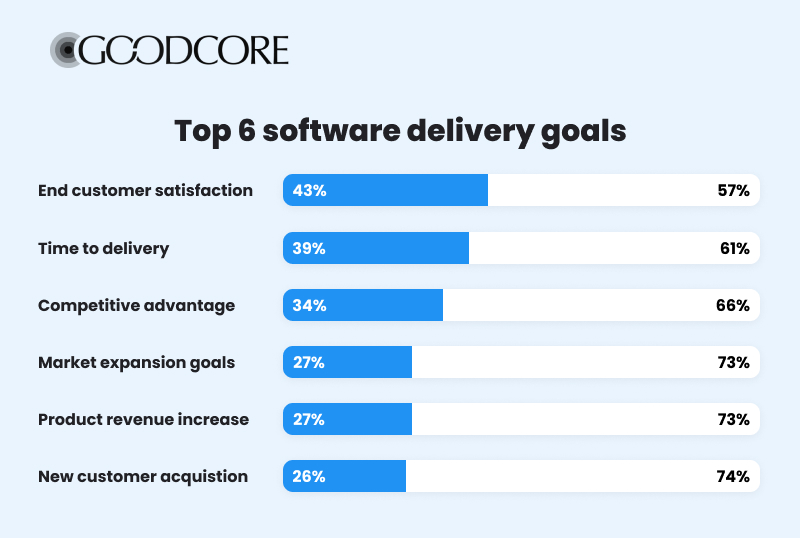
Source: 17th State of Agile Report
Read also: Iterative Software Development: An easy guide for beginners
Phases of the Agile SDLC
While the Agile Manifesto highlights core principles that underpin an Agile mindset, the Agile life cycle implements these principles into a structured series of stages representing iterative and incremental development. By following this iterative approach and coupling it with continuous feedback and adaption, the Agile SDLC enables early issue detections and corrections. This adapts the final product to evolving user requirements, creating a product that fits user needs like a glove.
The Agile SDLC is a dynamic framework consisting of several iterative phases. These six phases help break down the project’s life cycle to make the development process easier.
Phase 1: Discovery
In the first Agile SDLC stage, Agile begins with a well-defined concept, where Product Owners collaborate with key stakeholders to brainstorm and refine the product vision. Through collaboration, they uncover goals, challenges and resource considerations. Together, they map out the product backlog, development costs, and timelines to assess the project’s feasibility.
Phase 2: Design
Once requirements are finalised, members are assigned to the project and the focus shifts to creating a blueprint of the product. User requirements are studied in detail, which serve as a guideline for designing the product’s look and feel, architecture, and workflow. This is followed by iterative prototyping, where designs of the product are drawn and connected with user feedback loops to validate assumptions and align the product with user needs. A user-guided blueprint emerges through:
- User Story Mapping: outlining functionalities from the user’s perspective in the form of user stories
- System Architecture Design: defining the most suitable technical structure of the software
- UI/UX Design: designing an optimal user experience and interface, optimising it through iterative prototyping and gathering user feedback
Phase 3: Development
The development phase is where the product’s blueprint becomes reality. Using the design framework as guiding rails, the development team grooms the product backlog, breaking them into manageable chunks called sprints (typically lasting 2-4 weeks) and prioritising them. The first sprint usually focuses on building core functionality while additional features are added incrementally in later sprints. This iterative approach ensures valuable user feedback is consistently reflected in the end product.
To establish a constant stream of feedback, a sprint demo is held at the end of each sprint, where all completed work is demonstrated to key stakeholders for feedback. This is followed by a sprint retrospective which is a meeting in which the development team reflects on the sprint, discussing areas of strength and improvement to continually improve the development process. For day-to-day operations, daily scrum meetings are typically held to discuss statuses, challenges and synchronise development efforts
Phase 4: Testing
As highlighted in the Design phase, testing is a process that is woven throughout the agile software development life cycle. However, there’s a final testing stage before code release to minimise post-release defects. This testing is carried out by Quality Assurance (QA) Engineers who collaborate with developers to fix bugs as soon as they surface, covering the following areas:
- Unit testing: test individual functional units of code in isolation
- Integration testing: test how different components of software interact together
- System testing: test overall system functionality, ensuring it meets requirements
- Performance testing: test system speed & stability under specific workloads
- User acceptance testing: empower end-users to test software and refine the product using their valuable feedback
Read also: Software testing life cycle: A complete guide for 2024
Phase 5: Deployment
After successful sprint completion and rigorous testing, the product goes live and transitions from its staging environment to the live environment. By adopting a DevOps mindset, developers collaborate with deployment teams to ensure smooth and timely deployment without compromising stability or security.
Phase 6: Support
Agile’s lifecycle extends beyond deployment. The software enters an ongoing support phase where the development team monitors the deployed software, swiftly addressing user issues, resolving issues and incorporating sprint reviews into future iterations. This ensures a functional, relevant and user-friendly product.
It’s important to note that one of the defining features of the Agile SDLC is that no phase occurs in isolation, all Agile methodology stages instead overlap and iterate continuously throughout the development lifecycle.
Agile and DevOps: Bridging the gap
Agile has been a shift in paradigm in software development, allowing projects to thrive through collaborations and rapid iteration. However, this agility can get stuck in the handoff between development and operation teams. DevOps comes in to bridge this gap as an extension of the Agile methodology, by pulling operations into the umbrella of Agile. This means feedback flows to the development team faster, yielding the following benefits for organisations:
- Faster time to market
- More stable and reliable systems
- Easier experimentation and innovation
- Adapts to dynamic customer needs quicker
- Increases job satisfaction
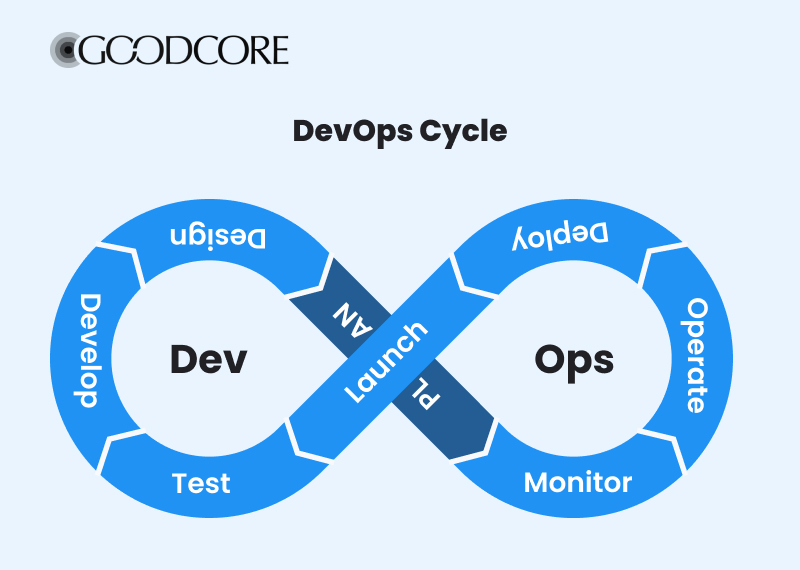
DevOps and Agile have become inseparable. Collaboration is the heartbeat of Agile and with disjointed development and operations, Agile loses its agility. Merging development with operations fosters a culture of shared responsibility throughout the software development life cycle. Both methodologies share a common goal: delivering value to customers faster, more efficiently and more effectively. DevOps extends Agile’s capabilities by addressing bottlenecks and implementing key practices:
| Practice | Description | Benefits |
| Continuous Integration (CI) | Automates merging code changes, building, and testing to catch errors early. | Faster feedback loops
Improved code quality Reduced broken builds. |
| Continuous Delivery (CD) | Extends CI by automating the deployment process to production or staging environments. | Faster releases
Reduced deployment risk Decrease time to market. |
| Infrastructure as Code (IaC) | Treats infrastructure like software code, enabling provisioning and management through code. | Consistency in deployment environments
Reduced manual errors Improved collaboration |
| Microservices and Containerization | Breaks down applications into small, independent services, packaged in containers for easy deployment. | Increased scalability
Improved maintainability Faster development cycles. |
| Monitoring and Logging | Continuously collects and analyzes data on application and infrastructure performance. | Improved troubleshooting
Faster issue identification Application health tracking |
Using the right tools for software development
For Agile and DevOps to thrive, a flexible infrastructure that allows the entire organisation and all relevant stakeholders to collaborate seamlessly is a foundational element. This is especially important when working with remote agile teams, as infrastructure that gives you visibility and includes you in the development process is essential in delivering a successful project. A report by Google Cloud’s DevOps Research and Assessment team found flexible infrastructures predict 30% higher organisational performance than inflexible infrastructures.
Utilising modern tools that facilitate Agile and DevOps frameworks can streamline your workflows and ease your transition:
| Tools | Description |
| Jira | a popular tool for agile software development, offering features like spring planning, backlog management, issue tracking, kanban boards and extensive workflow customization options. |
| Trello | a simple and easy-to-use visual kanban board which helps teams organise tasks in stages. |
| Asana | a work management platform offering planning, tracking and collaboration tools for projects. It allows you to manage kanban boards, timelines and integrations. |
| Wrike | similar to Asana, Wrike offers agile management features like task management, gantt charts and in-built messaging. |
| Basecamp | a central hub for project communication that is simple and easy to use allowing you to maintain a centralised knowledge base. |
| Monday | another work management software that leverages powerful visuals to streamline your workflows |
| Slack | powerful team communication and collaboration platform with robust search functionality, customizable notifications and extensive integrations. |
| Microsoft Teams | another powerful chat-based communication platform tightly integrated with Microsoft’s ecosystem, allowing file sharing and video conferencing amongst other integrations. |
| Azure DevOps | a cloud-based development platform by Microsoft, offering version control, CI/CD pipelines, and project management services. |
| GitHub | A web-based code repository hosting service focused on fostering collaboration and version control for software development projects. |
| GitLab | Another comprehensive code repository combining source code management with collaboration and development operations tools, offering deeper customisation |
| Confluence | Collaboration software that enables teams to create, share, and collaborate on projects and documentation. |
| Notion | A workspace tool for note-taking, project management, and collaboration, featuring customizable layouts and integrations. |
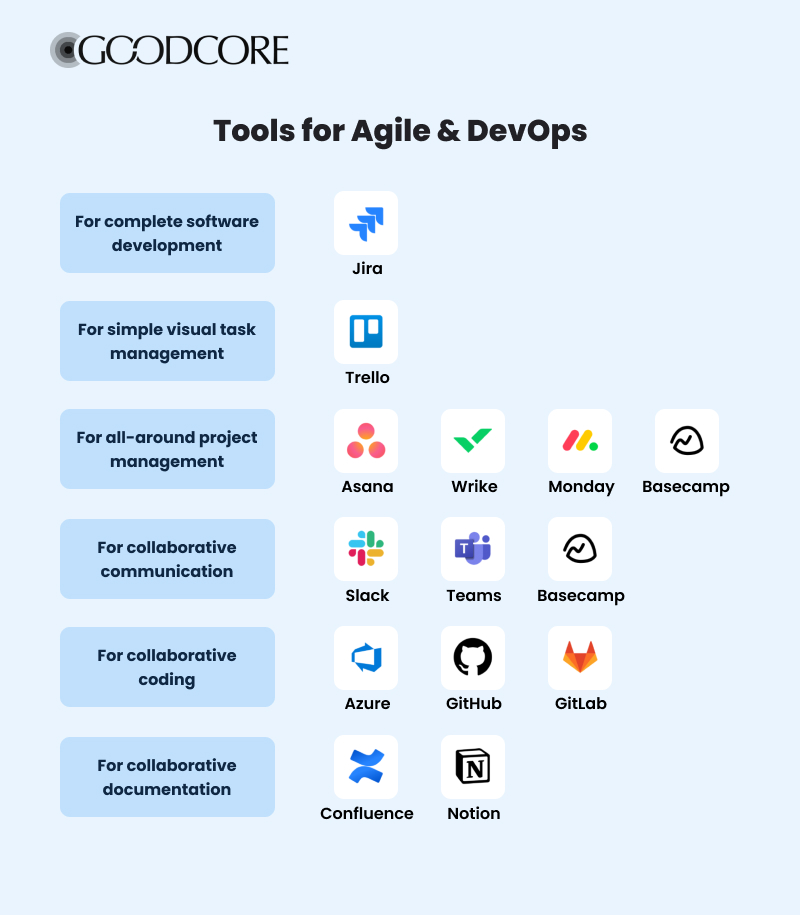
GoodCore’s top 4 challenges of embracing Agile
Challenge # 1: Agile-Waterfall integration
Integrating Agile software development into small and medium-sized businesses (SMBs) with traditional, waterfall-like operations presents a unique set of challenges. SMBs often have established, rigid processes and longer decision-making cycles, contrasting with Agile’s flexibility and speed. This discrepancy can cause friction in project timelines and expectations, requiring a careful balance to deliver high-quality software solutions. For example, key challenges might include:
- Communication and expectation management: Maintaining clear communication with SMB clients to manage expectations around project timelines and deliverables.
- Process alignment: Aligning Agile methodologies with the client’s more sequential processes without compromising Agile’s core principles.
- Decision-making speed: Navigating SMBs’ slower decision-making processes to maintain Agile’s rapid development cycle.
- Integration of deliverables: Seamlessly integrating Agile’s iterative outputs into the client’s existing systems and workflow.
Strategic solutions:
- Hybrid Approach: We usually create a hybrid methodology that merges Agile’s flexibility with the structured nature of waterfall processes to suit client operations.
- Stakeholder engagement: By fostering collaboration and understanding through regular stakeholder updates, demos, and feedback sessions.
- Flexible roadmaps: We implement adaptable project roadmaps that provide both Agile responsiveness and the predictability desired by SMBs.
- Educational initiatives: Additionally, we can conduct workshops to educate SMB clients on Agile benefits and its potential synergy with their existing processes at the very beginning of our cooperation
Challenge # 2: Balancing flexibility with consistency and quality control
The Agile SDLC model’s inherent flexibility often clashes with the imperative for consistent product and code quality. This tension arises from Agile’s emphasis on adaptation and responding to change. To solve this we need to ensure that adaptability remains a core strength while achieving consistent quality.
Strategic solutions:
- Establishing a comprehensive Definition of Done (DoD): From the outset of our collaboration, we’ll set detailed quality benchmarks and acceptance criteria. This DoD serves as our project’s quality compass, ensuring every deliverable meets the high standards expected by our clients.
- Regular communication: We commit to keeping communication channels open at all times. This ensures a constant flow of feedback and dialogue, allowing us to align expectations with actual outcomes effectively.
- Continuous feedback loops: Regular feedback loops are integral to our approach, enabling us to swiftly adjust our strategy as needed. This dynamic adjustment process ensures our client’s objectives are met without sacrificing the adaptability that the Agile model offers.
Challenge # 3: Managing scope creep in Agile software development projects
Agile’s inherent flexibility, while beneficial for accommodating change and fostering innovation, can inadvertently lead to scope creep. This is particularly pronounced in outsourced projects, where direct oversight is limited, and continuous changes can expand the project scope beyond initial agreements, affecting timelines and budgets.
Strategic solutions:
- Goal and role clarity: At the project’s onset, we try to establish clear, documented project goals, roles, and responsibilities to serve as a reference point for all stakeholders.
- Regular progress reviews: For this, our project managers or technical team leads implement systematic progress reviews to assess how well the project aligns with the initial goals and objectives. These reviews serve as checkpoints to ensure that any deviations are intentional, justified, and aligned with the client’s strategic interests.
- Dynamic adjustment mechanism: For this, we usually have a process for evaluating and integrating changes that may affect the project scope. This includes setting criteria for change acceptance and ensuring that any adjustments are made with full awareness of their impact on project resources and timelines.
Challenge #4: Aligning goals and mindset
Individuals and teams often diverge in their understanding of agile software development project project priorities. With many moving pieces, aligning goals can prove difficult and needs to be simplified using planning tools. Without alignment, projects are susceptible to delays, cost overruns, and quality issues.
Strategic solutions:
- Single source of truth: Using specialized software, we create a centralized knowledge base to store all project-related information and goals. This includes visual tools like Kanban Boards and Gantt Charts that enhance clarity. This ensures that we create a single point of reference for our team and client ensuring everyone has access to updated information.
- Daily standup meetings: By incorporating daily scrums in our meetings, we provide a forum for our team members to share progress updates, identify roadblocks and collaboratively adjust plans as needed.
- Retrospectives and lessons learnt: We conduct retrospectives at the end of each sprint, discussing what went well, what didn’t and areas for improvement. These introspective sessions create valuable learning opportunities, helping with continuous improvement and alignment.
Instantly access Agile through remote development teams
Agile has become a standard for swiftly delivering products that truly add value. However, navigating the complexities of the Agile Software Development Life Cycle sometimes feels like traversing a maze. Building Agile teams from the ground up demands time, resources and expertise. It’s more than assembling technically competent individuals, it’s about driving a culture of close collaboration, adaptability, and continuous improvement.
We understand that while building an Agile team internally presents its own set of challenges, finding a truly Agile team can be tough. Therefore, at Goodcore, we empower you with instant access to hand-picked dedicated Agile teams with the right expertise to tackle your challenges. With a proven track record and more than eighteen years of experience, Goodcore is your trusted software development partner.
Get in touch with us today to discover how we can unleash your business’s potential!





